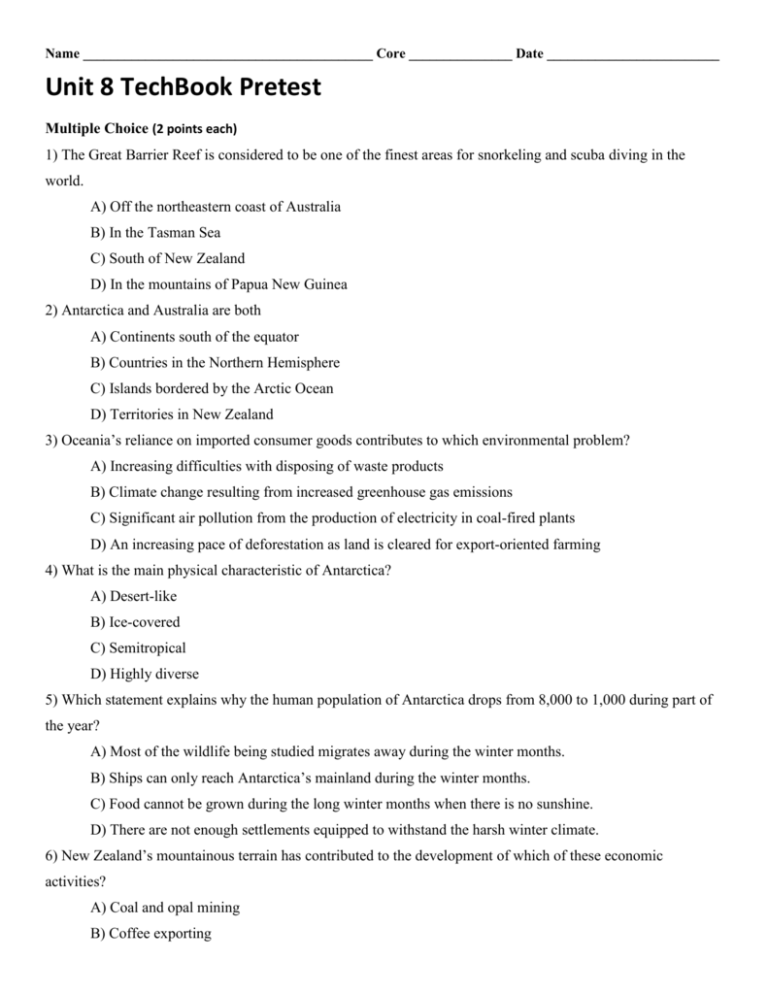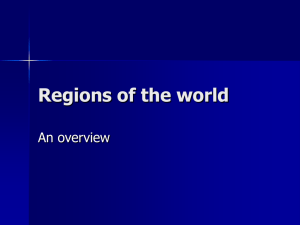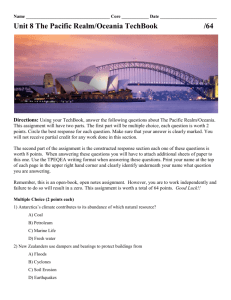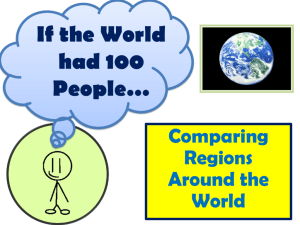Unit 8 TechBook Pretest
advertisement

Name __________________________________________ Core _______________ Date _________________________ Unit 8 TechBook Pretest Multiple Choice (2 points each) 1) The Great Barrier Reef is considered to be one of the finest areas for snorkeling and scuba diving in the world. A) Off the northeastern coast of Australia B) In the Tasman Sea C) South of New Zealand D) In the mountains of Papua New Guinea 2) Antarctica and Australia are both A) Continents south of the equator B) Countries in the Northern Hemisphere C) Islands bordered by the Arctic Ocean D) Territories in New Zealand 3) Oceania’s reliance on imported consumer goods contributes to which environmental problem? A) Increasing difficulties with disposing of waste products B) Climate change resulting from increased greenhouse gas emissions C) Significant air pollution from the production of electricity in coal-fired plants D) An increasing pace of deforestation as land is cleared for export-oriented farming 4) What is the main physical characteristic of Antarctica? A) Desert-like B) Ice-covered C) Semitropical D) Highly diverse 5) Which statement explains why the human population of Antarctica drops from 8,000 to 1,000 during part of the year? A) Most of the wildlife being studied migrates away during the winter months. B) Ships can only reach Antarctica’s mainland during the winter months. C) Food cannot be grown during the long winter months when there is no sunshine. D) There are not enough settlements equipped to withstand the harsh winter climate. 6) New Zealand’s mountainous terrain has contributed to the development of which of these economic activities? A) Coal and opal mining B) Coffee exporting C) Timber harvesting D) Sheep and livestock production 7) Overgrazing and drought in Australia have contributed to A) Deforestation B) Desertification C) Water pollution D) Climate change 8) Which statement explains why the majority of Australia’s population lives on or near the coast? A) The Aborigines who live in the interior of Australia are hostile and semi nomadic. B) The coastal areas of Australia have a milder climate and better conditions for farming. C) Most of Australia’s industrial output moves from the far interior to the coast. D) The Aborigines were pushed to the coasts as European settlers moved into the interior. 9) The indigenous peoples of New Zealand originally traveled from A) Australia B) Polynesia C) Antarctica D) North America 10) Why are the Aborigines of Australia different from other native peoples around the world? A) They were the first native peoples to abandon the hunter-gatherer lifestyle. B) They are the descendents of humans who came from Europe instead of Asia. C) They originally migrated entirely along water routes instead of over land bridges. D) They have lived in the same territory for longer than any other native population. 11) Which factor explains why Australia’s fishing industry is large and important? A) The country’s long coastline B) The harsh climate on the coast C) The increasing number of river dams D) The shortage of fish in other parts of Oceania 12) Which natural disaster is more likely to occur in New Zealand than in Australia? A) A flood B) A hurricane C) A severe drought D) A volcanic eruption 13) Which statement explains why Australia’s Aborigines developed a nomadic hunting and gathering lifestyle? A) Much of Australia is too barren to grow food. B) Australia has an abundant supply of game animals. C) The flat terrain in much of Australia is ideal for hunting. D) The long coastline of Australia makes farming unnecessary. 14) An Australian rancher is most likely to have a problem with A) Frequent droughts B) Attacks by hostile Aborigines C) Competition for land from famers D) A lack of demand for locally grown meat 15) Which statement explains how Antarctica’s harsh climate impacts its human inhabitants? A) Humans cannot live on Antarctica during the winter months. B) Since few plants grow on Antarctica, food must be brought in from abroad. C) Because of a lack of forests, all dwellings must be built from ice and snow. D) The formation of sea ice prevents people from leaving during much of the year. 16) Scientific researchers on Antarctica need A) Special clothing to withstand the harsh climate B) Unusual immunizations to prevent rare diseases C) Training in the construction of snow and ice dwellings D) Frequent delivery of snow and ice from Europe 17) What is the main reason Christianity is the most commonly practiced religion in Australia, New Zealand, and Oceania? A) More than half the people of the islands live in urban areas. B) The region was isolated from most of the world until the 1700s C) Descendants of European settlers form a majority of the population. D) Many inhabitants hold firmly to native beliefs passed down from their ancestors. 18) Experts believe that the first people to migrate to Australia and the Pacific Islands came from A) Asia B) Africa C) Europe D) New Zealand 19) During the 1700s, British officials decided to turn Australia into A) A research station B) An indigenous community C) A region for subsistence farming D) A penal colony 20) Australia remained part of the British Empire until A) 1840 B) 1878 C) 1901 D) 1947 21) Which statement describes the importance of McMurdo Station in Antarctica? A) It is a base for scientific research. B) It is located in a harsh, cold climate. C) It supplies other research facilities. D) It has a permanent resident population. 22) Which statement about the cities of Australia and New Zealand is accurate? A) They lack major cultural centers. B) They are largely devoted to banking and finance. C) They have well-developed transportation and communication systems. D) They are populated mostly by recent immigrants. 23) The nations who signed the Antarctic Treaty have the power to A) Build military bases on Antarctica B) Establish a parliament to rule Antarctica C) Sell portions of Antarctica for private development D) Write regulations governing fishing around Antarctica 24) Most of the residents of Antarctica are involved in which activity? A) Fishing B) Mining precious metals C) Tourism D) Scientific research 25) The type of government used in Australia and New Zealand is a A) Military dictatorship B) Democratic republic C) Constitutional monarchy D) Parliamentary commonwealth 26) Which statement best describes the economies of the nations of Oceania? A) They rely largely on tourism and agriculture. B) They are international banking centers. C) They are noted for the production and distribution of movies. D) They grow cotton for their textile mills. 27) How could the owner of an Australian coastal resort hotel near the Great Barrier Reef help to prevent reef damage? A) By providing sunscreen lotions to the hotel’s guests B) By organizing boating and snorkeling expeditions to the reef C) By petitioning the government to ease limits on carbon emissions D) By disposing of garbage and sewage so that they do not run into the ocean 28) Coral reefs are formed from A) The skeletons of dead whales B) Coral that emerges from cracks in the earth’s crust C) Coral polyps that grow together to form colonies D) Plants that are covered with crusted remains of fish 29) Why might the loss of even small portions of the Great Barrier Reef have long-lasting consequences? A) The reef protects the ocean floor faults. B) The reef grows very slowly. C) The reef is home to gigantic aquatic mammals. D) The reef serves as habitat for thousands of migratory birds. 30) Which represents a major environmental threat to the Great Barrier Reef? A) Overabundance of whales B) Global warming C) Cooler ocean waters D) Excessive sunlight Constructed Response (15 points) Answer one of the following questions about The Pacific Realm/Oceania. Use complete sentences when answering the questions. Your answer should be at least 35 words. 1. How does geography influence life, or lack of life, in Australia, Oceania, and Antarctica? 2. How have people interacted with the environment in Australia, Oceania, and Antarctica? 3. How have patterns of migration changed the cultures of Australia, Oceania, and Antarctica? 4. How have natural history and geography influenced the political and economic structures in Australia, Oceania, and Antarctica? 5. How have humans impacted life in underwater ecosystems?








